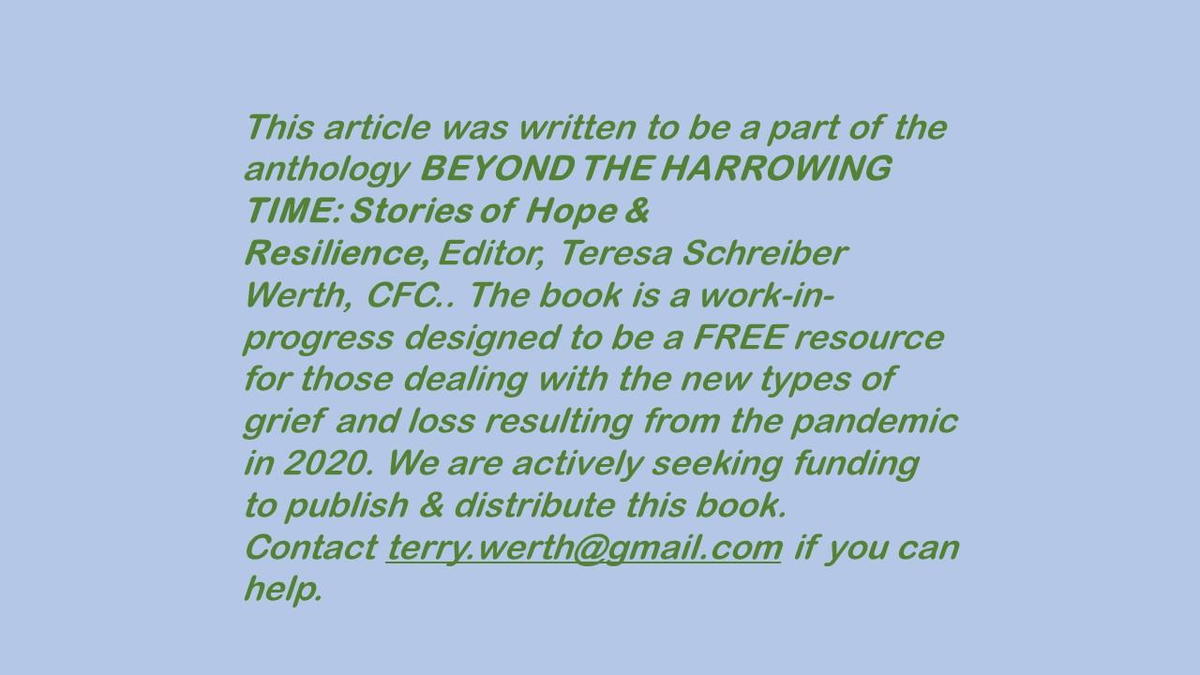
By Lynn M. Acquafondata
Death like the rest of life doesn’t always unfold in tidy, predictable scenes. Sometimes far from it. Especially during a pandemic.
When death comes unexpectedly and we are forced to stay away or can’t get there in time, we don’t just grieve our family member or close friend, we lament the chance to say a final goodbye in a way that feels right and makes sense.
We like to imagine an ideal bittersweet ending, surrounded by family or close friends, holding hands, whispering soft “I love you's”, sharing words of forgiveness or having one last laugh. We don’t imagine someone alone and afraid in a hospital room with anguished loved ones staying away for their own safety.
We expect predictable rituals like a funeral or memorial service within a set time frame. Deeply painful, but comforting. Not hurried cremations and online memorials. We take for granted that people can bring casseroles, share memories and hold us close as we grapple with our loss. We don’t imagine difficult choices about when or whether to gather at all.
Seven Elements of Meaningful Goodbye
No matter what the circumstances, key elements are usually essential for a meaningful goodbye. All of these are still possible even during a pandemic. They just require a different approach. Our typical death traditions and rituals accomplish some of these objectives without our needing to understand the psychological and emotional details of what is taking place. When we can’t follow the usual customs, understanding the underlying needs and purposes can help us figure out how to create meaningful alternatives, or how to offer helpful possibilities to those we are trying to support.
A meaningful final goodbye includes:
- Telling the story. Grieving in the presence of others.
- Saying goodbye in words, music, imagery, prayer, and/or ritual.
- Recognizing and honoring the person’s life including the way they made a difference in people’s lives and in the ways they have contributed to who we are.
- Recognizing a person’s flaws and faults, acknowledging the pain of these flaws and coming to terms with unresolved conflict.
- Being able to picture the person in a safe space after death.
- Finding meaning and purpose in our own life after a loved one’s death.
- Letting go of the illusion that grief eventually ends.
Engaging the Elements of Grief in New Ways
Telling the story. Grieving in the presence of others.
We need to talk about the person, about who they were, about what they meant to us. We need to talk about what happened, sometimes over and over to try to make sense of it. If this can’t happen in formal in-person gatherings and visits, it can happen on the phone or online or even in letters or emails.
As a grief counselor, I used to tell people I would never lead grief groups online. I believed that people needed to be physically in each other’s presence to support each other in grief. And yes, that is the ideal. But then the Covid-19 shutdowns changed our lives. Despite the shortcomings of the screen, and overcoming technology challenges, people come away from online grief groups feeling heard and understood, able to face one more day.

Saying goodbye in words, music, imagery, prayer, and/or ritual.
There are many other ways to do this when funerals and memorial services are delayed. Some people create artwork or music. Some visit all the places that were special to the person who died. Some write a letter to that person expressing all that needed to be said but wasn’t. Some people say goodbye in significant and healing ways in dreams.
Recognizing and honoring the person’s life including the way they made a difference in people’s lives and in the ways they have helped to make us who we are.
In addition to funerals and memorial services, this can happen when we do something to honor the person who died: make a donation to a meaningful charity, create a memorial of some kind, do something to take care of someone else. Some of these could happen in phones calls and conversations from a distance, or online memorials.
Recognizing a person’s flaws and faults, acknowledging the pain of these flaws and coming to terms with unresolved conflict.
Coming to terms with the ways in which people and relationships are not perfect is important. This can be one of the hardest parts of grief and is often avoided, even in usual circumstances. Some relationships cause deep pain and even lasting damage. In these cases it can be helpful to do this work with the assistance of a professional therapist or counselor. Appointments are available online through tele-mental health.
Being able to be able to picture the person in a safe space after death.
There is not one vision of what this safe space is. It might be an understanding of an afterlife or the promise of reuniting with the person after death. It might be a sense of peace about a gravesite or the place where the ashes are scattered. It might involve living out the person’s values in our own life. It might be an image of the person being welcomed and watched over by those who have already died. It might be reassurance from the person themselves that they are OK through a sign, a dream or just an inner sense. It might be an understanding that the person has become one with the universe in some way. All of these things can happen from miles away or years later.
Finding meaning and purpose in our own life after the loved one’s death.
This is a very individual element of grief that depends on one’s relationship with the person who died and one’s stage of life. It involves coming to terms with changes in roles and relationships, and daily activities. Some people benefit from doing this with the help of a professional therapist or counselor. These services are available online through tele-mental health.
Letting go of the illusion that grief eventually ends.
Many companies expect people back at work within days. Neighbors, acquaintances and family advice directly or indirectly, that it’s time to move on. But even in the best of circumstances, grief for a close loved one can change over time but it doesn’t end. There is some comfort in that realization. It’s OK to hold onto and come back to feelings of loss. Maybe we will find that memorial services six or nine months later will fill a deep need for continuing support that people didn’t realize they had.
Saying a meaningful final goodbye is possible when we are denied a last goodbye in person. At the same time a meaningful final goodbye is not the end of grief.
This essay was written to be a part of the anthology BEYOND THE HARROWING TIME: Stories of Hope & Resilience, Editor, Teresa Schreiber Werth, CFC.. The book is a work-in-progress designed to be a FREE resource for those dealing with the new types of grief and loss resulting from the pandemic in 2020. We are actively seeking funding to publish & distribute this book. Contact [email protected] if you can help.
Image courtesy of pixabay.
